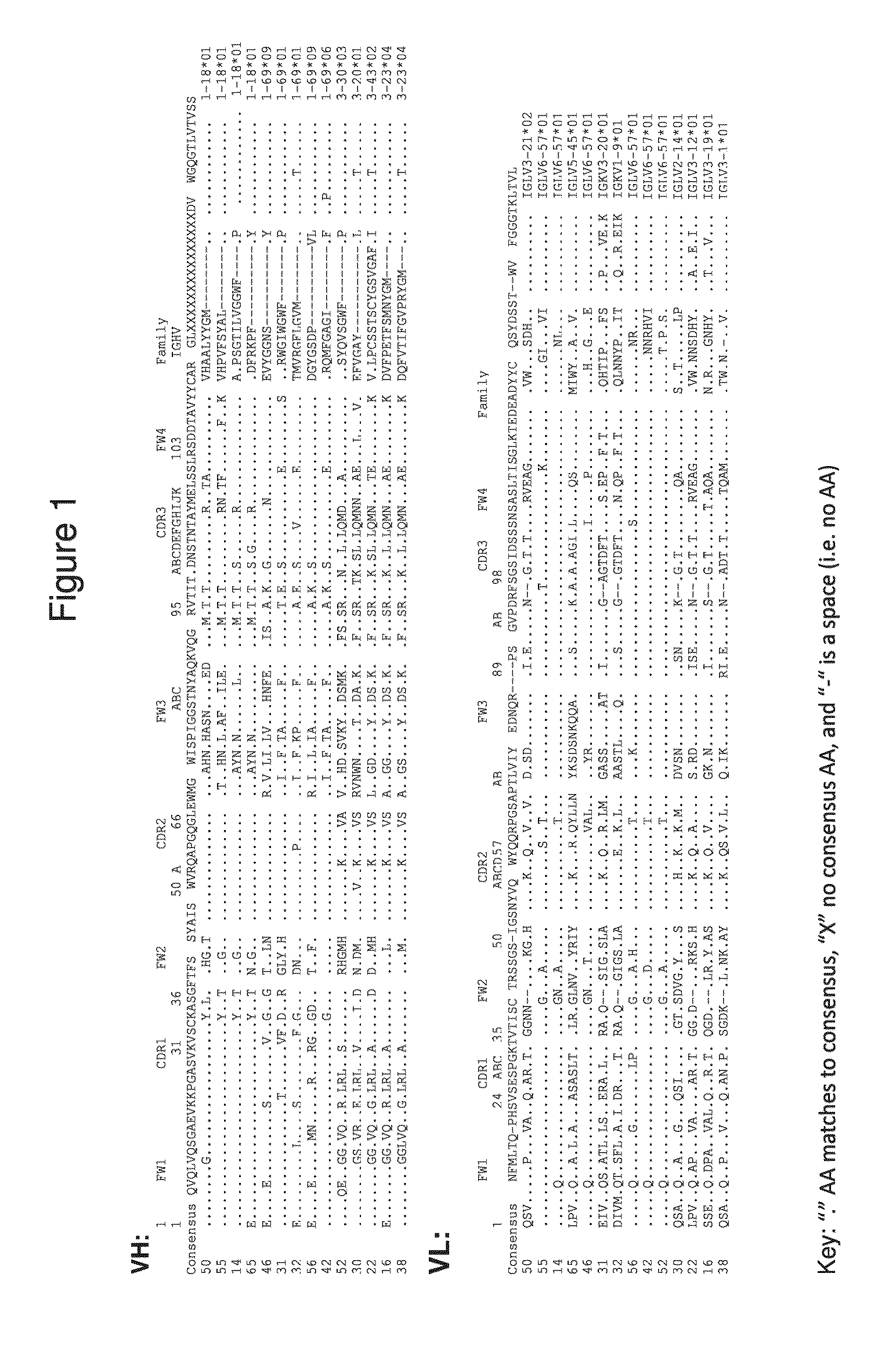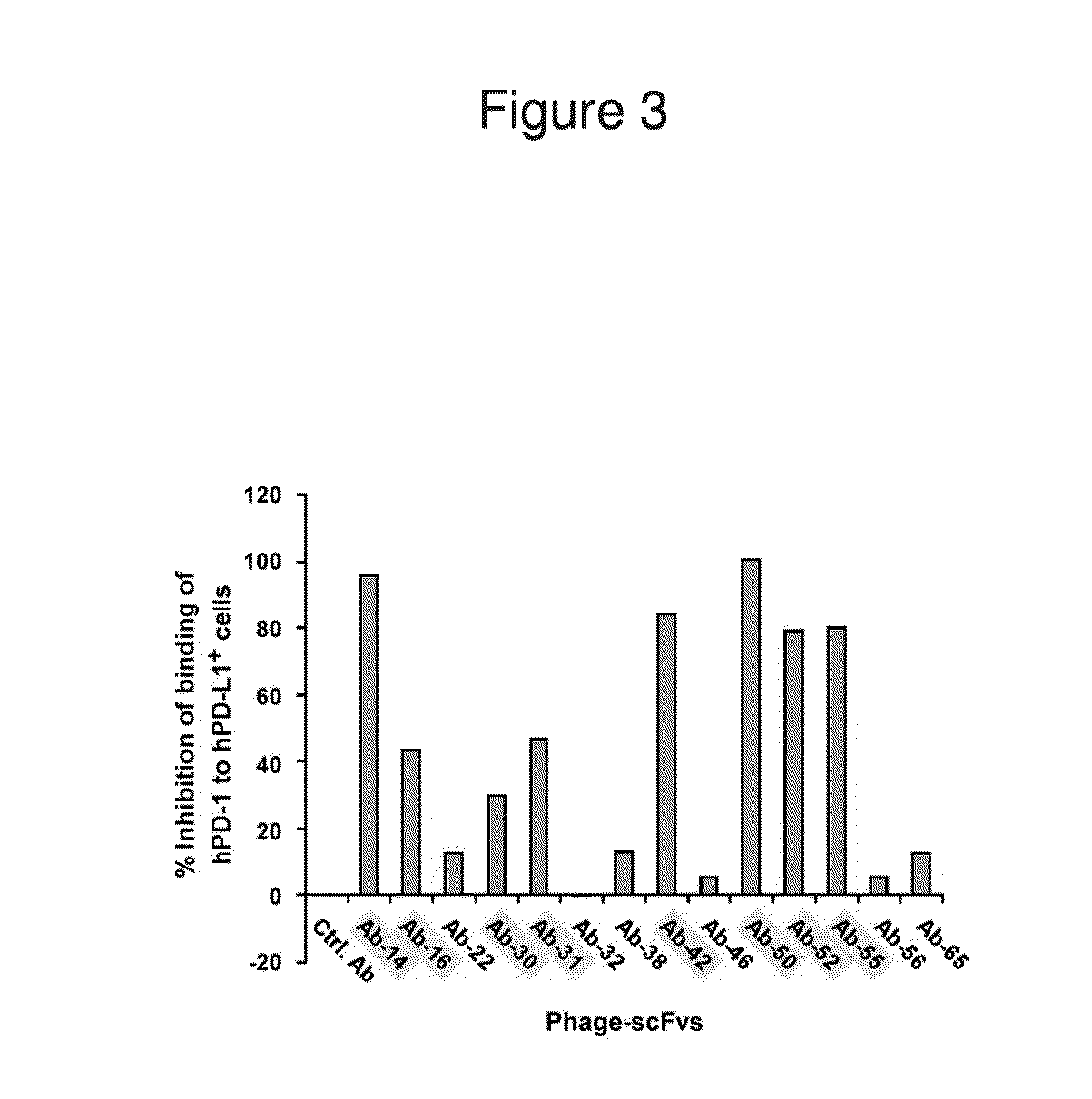Human monoclonal Anti-pd-l1 antibodies and methods of use
a monoclonal antibody and human antibody technology, applied in the field of antipdl1, can solve the problems of the progression physical deletion of the antigen-specific t cells themselves, and achieve the effect of increasing the activity of the antigen-specific t cell, enhancing the immune respons
- Summary
- Abstract
- Description
- Claims
- Application Information
AI Technical Summary
Benefits of technology
Problems solved by technology
Method used
Image
Examples
example 1
Generation of Human mAbs Against Pd-L1
[0163]Human mAbs against human PD-L1 were generated by panning against a 27-billion member human scFv phage display library. Using full length PD-L1 in the form of paramagnetic proteoliposomes (PMPL), which assure proper orientation of the extracellular domain of PD-L1 for presentation to the library, 14 unique scFv-phage were identified that bind PD-L1. Human IgG constructs were constructed for these 14 unique scFv-phage: Ab-14, Ab-16, Ab-22, Ab-30, Ab-31, Ab-32, Ab-38, Ab-42, Ab-46, Ab-50, Ab-52, Ab-55, Ab-56 and Ab-65.
Example 2
Characterization of huPD-L1 mAbs Binding to Pd-L1
[0164]Binding analysis of huPD-L1 antibodies were performed using PD-L1-expressing cells. Four types of cells were tested, including parental cell line 300.19, and transfected cell lines expressing human PD-L1 (hPD-L1), human PD-L2 (HPD-L2), and human C-type lectin domain family 2 member (hCLEC2D). The binding assays were performed in duplicate, with the results summarize...
example 2
Characterization of Anti-PD-L1 Phage-Antibodies Blocking PD / PD-L1 Binding
[0166]A competitive FACS analysis was performed to characterize the inhibition of hPD1 binding to hPD-L1 by anti-PD-L1 phage antibodies. All anti-hPD-L1 antibodies were in phage-scFv form. 293T cells were transfected with a vector encoding human PD-L1 fused to human Fc region for expression of hPD-L1-Fc. In this assay, 1012 plaque-forming units (pfu) of phage-scFvs were mixed with about 0.25 mg / ml of soluble hPD-1-hFc fusion protein and then added to the hPD-L1-expressing 293T cells. After washing, the cells were incubated with FITC-anti-human IgG antibody and analyzed by FACS to measure the binding of hPD1-hFc to hPD-L1 on the cell surface.
[0167]Fluorescence values were obtained by FACS analysis and used to generate a percentage of inhibition of binding of hPD-1 to hPD-L1+ cells. These values are displayed in FIG. 3. Almost all anti-PD-L1 phage scFvs demonstrated some ability to inhibit the binding of hPD-1 to...
example 3
Characterization of huPD-L1 Soluble Mabs Blocking PD / PD-L1 Binding
[0168]A competitive FACS analysis was performed to characterize the inhibition of hPD1 binding to hPD-L1 by the soluble huPD-L1 antibodies of the present invention. All huPD-L1 antibodies were tested for their ability to inhibit the binding of hPD1-IgG fusion protein with hPD-L1-expressing 300.19 cells. In this assay, 50,000 cells expressing hPD-L1 were pre-incubated with the huPD-L1 or control antibodies for 30 minutes at the following concentrations: 10 μg / ml, 1 μg / ml, 0.1 μg / ml and 0.01 μg / ml. After the pre-incubation, 0.125 μg of human PD1 fused to mouse IgG2α was added to the cells and incubated for another 30 minutes. The cells were washed twice, and then 0.125 μg of goat anti-mouse IgG2α-PE antibody was added to the cells. After 30 minutes of incubation, the cells were washed twice and then analyzed by FACS. The values obtained from FACS analysis are represented as mean fluorescence intensity units (MFI) and ar...
PUM
| Property | Measurement | Unit |
|---|---|---|
| time | aaaaa | aaaaa |
| temperature | aaaaa | aaaaa |
| concentrations | aaaaa | aaaaa |
Abstract
Description
Claims
Application Information
 Login to View More
Login to View More - R&D
- Intellectual Property
- Life Sciences
- Materials
- Tech Scout
- Unparalleled Data Quality
- Higher Quality Content
- 60% Fewer Hallucinations
Browse by: Latest US Patents, China's latest patents, Technical Efficacy Thesaurus, Application Domain, Technology Topic, Popular Technical Reports.
© 2025 PatSnap. All rights reserved.Legal|Privacy policy|Modern Slavery Act Transparency Statement|Sitemap|About US| Contact US: help@patsnap.com



